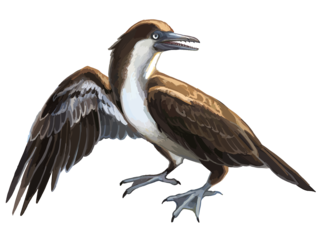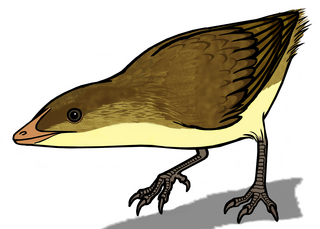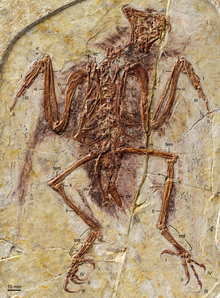
Confuciusornis is a genus of basal crow-sized avialan from the Early Cretaceous Period of the Yixian and Jiufotang Formations of China, dating from 125 to 120 million years ago. Like modern birds, Confuciusornis had a toothless beak, but closer and later relatives of modern birds such as Hesperornis and Ichthyornis were toothed, indicating that the loss of teeth occurred convergently in Confuciusornis and living birds. It was thought to be the oldest known bird to have a beak, though this title now belongs to an earlier relative Eoconfuciusornis. It was named after the Chinese moral philosopher Confucius. Confuciusornis is one of the most abundant vertebrates found in the Yixian Formation, and several hundred complete specimens have been found.

The Enantiornithes, also known as enantiornithines or enantiornitheans in literature, are a group of extinct avialans, the most abundant and diverse group known from the Mesozoic era. Almost all retained teeth and clawed fingers on each wing, but otherwise looked much like modern birds externally. Over eighty species of Enantiornithes have been named, but some names represent only single bones, so it is likely that not all are valid. The Enantiornithes became extinct at the Cretaceous–Paleogene boundary, along with Hesperornithes and all other non-avian dinosaurs.

Avisaurus is a genus of enantiornithine bird from the Late Cretaceous of North America.

Yanornis is an extinct genus of fish-eating Early Cretaceous birds. Two species have been described, both from Liaoning province, China: Yanornis martini, based on several fossils found in the 120-million-year-old Jiufotang Formation at Chaoyang, and Yanornis guozhangi, from the 124-million-year-old Yixian Formation.

Longipteryx is a genus of prehistoric bird which lived during the Early Cretaceous. It contains a single species, Longipteryx chaoyangensis. Its remains have been recovered from the Jiufotang Formation at Chaoyang in Liaoning Province, China. Apart from the holotype IVPP V 12325 - a fine and nearly complete skeleton — another entire skeleton and some isolated bones are known to date.

Eoalulavis is a monotypic genus of enantiornithean bird that lived during the Barremian, in the Lower Cretaceous around 125 million years ago. The only known species is Eoalulavis hoyasi.
Neuquenornis volans is a species of enantiornithean birds which lived during the late Cretaceous period in today's Patagonia, Argentina. It is the only known species of the genus Neuquenornis. Its fossils were found in the Santonian Bajo de la Carpa Formation, dating from about 85-83 million years ago. This was a sizeable bird for its time, with a tarsometatarsus 46.8mm long. Informal estimates suggest that it measured nearly 30 cm (12 in) in length excluding the tail.

Pygostylia is a group of avialans which includes the Confuciusornithidae and all of the more advanced species, the Ornithothoraces.

Protopteryx is an extinct bird and possibly the basalmost enantiornithean, from the Cretaceous period. The type species is P. fengningensis. It was first discovered in the Sichakou Member of the Yixian Formation or Huajiying Formation of Hebei Province, northern China, dating from 131 Ma ago. Protopteryx has been found in the Daibeigou formation, as well. The name Protopteryx means "primitive feather": "proto-" meaning "the first of" and "-pteryx" meaning "feather" or "wing." The name comes from the fact that Protopteryx feathers are more primitive than those of modern birds, such as the two elongated tail feathers that lack barbs and rami.

Avisauridae is a family of extinct enantiornithine dinosaurs from the Cretaceous period, distinguished by several features of their ankle bones. Depending on the definition used, Avisauridae is either a broad and widespread group of advanced enantiornithines, or a small family within that group, restricted to species from the Late Cretaceous of North and South America.

Shanweiniao is a genus of long-snouted enantiornithean birds from Early Cretaceous China. One species is known, Shanweiniao cooperorum. There is one known fossil, a slab and counterslab. The fossil is in the collection of the Dalian Natural History Museum, and has accession number DNHM D1878/1 and DNHM1878/2. It was collected from the Lower Cretaceous Dawangzhengzi Beds, middle Yixian Formation, from Lingyuan in the Liaoning Province, China.

Songlingornithidae is a family of basal euornithean dinosaurs from the Early Cretaceous of China. All known specimens come from the Jiufotang Formation and the Yixian Formation, dating to the early Barremian and Aptian ages, 125–120 million years ago.

Longipterygidae is a family of early enantiornithean avialans from the Early Cretaceous epoch of China. All known specimens come from the Jiufotang Formation and Yixian Formation, dating to the early Aptian age, 125-120 million years ago.
Ambiortiformes is a group of prehistoric ornithuromorph dinosaurs.

Sulcavis is a genus of enantiornithean birds. One species is named, Sulcavis geeorum. The fossil was found in Early Cretaceous rocks in Liaoning Province, China.

Bohaiornithidae is a group of early predatory enantiornithean dinosaurs from the early Cretaceous Period of China. All known specimens come from the Jiufotang Formation and Yixian Formation, dating to the early Aptian age, 125–120 million years ago. Bohaiornithidae was first coined by Wang and colleagues in 2014. They defined it as the natural group formed by all descendants of the common ancestor of the type species, Bohaiornis guoi, and Shenqiornis mengi.

Luis María Chiappe is an Argentine paleontologist born in Buenos Aires who is best known for his discovery of the first sauropod nesting sites in the badlands of Patagonia in 1997 and for his work on the origin and early evolution of Mesozoic birds. He is currently the Vice President of Research and Collections at the Natural History Museum of Los Angeles County and director of the museum's Dinosaur Institute. He was a postdoctoral researcher at the American Museum of Natural History, New York after immigrating from Argentina. Chiappe is currently the curator of the award winning Dinosaur Hall at the Natural History Museum of Los Angeles County, an adjunct professor at the University of Southern California, BBC advisor and author of scientific and popular books.

Jingmai Kathleen O'Connor is a paleontologist who works as a curator at the Field Museum.

Beiguornis is a genus of bohaiornithid dinosaurs from the Early Cretaceous Longjiang Formation of Inner Mongolia, China. The genus contains a single species, Beiguornis khinganensis. Beiguornis is the first and only enantiornithine known from the Longjiang Formation. In the phylogenetic analysis conducted by the describing authors, Beiguornis formed a monophyletic group with the bohaiornithids Sulcavis and Zhouornis.

















